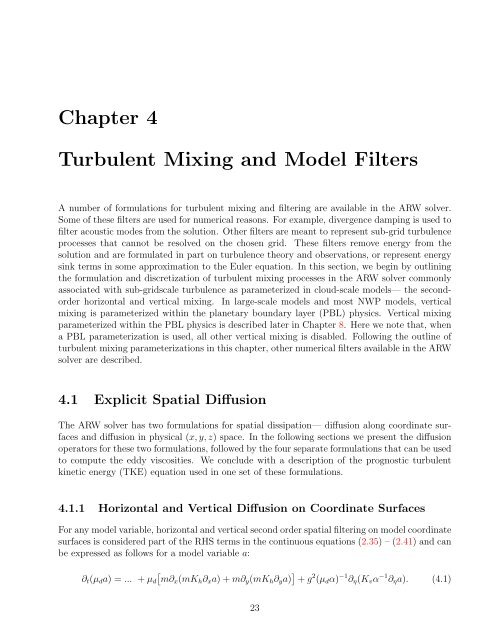Advanced Research WRF (ARW) Technical Note - MMM - University ...
Advanced Research WRF (ARW) Technical Note - MMM - University ...
Advanced Research WRF (ARW) Technical Note - MMM - University ...
You also want an ePaper? Increase the reach of your titles
YUMPU automatically turns print PDFs into web optimized ePapers that Google loves.
Chapter 4<br />
Turbulent Mixing and Model Filters<br />
A number of formulations for turbulent mixing and filtering are available in the <strong>ARW</strong> solver.<br />
Some of these filters are used for numerical reasons. For example, divergence damping is used to<br />
filter acoustic modes from the solution. Other filters are meant to represent sub-grid turbulence<br />
processes that cannot be resolved on the chosen grid. These filters remove energy from the<br />
solution and are formulated in part on turbulence theory and observations, or represent energy<br />
sink terms in some approximation to the Euler equation. In this section, we begin by outlining<br />
the formulation and discretization of turbulent mixing processes in the <strong>ARW</strong> solver commonly<br />
associated with sub-gridscale turbulence as parameterized in cloud-scale models— the secondorder<br />
horizontal and vertical mixing. In large-scale models and most NWP models, vertical<br />
mixing is parameterized within the planetary boundary layer (PBL) physics. Vertical mixing<br />
parameterized within the PBL physics is described later in Chapter 8. Here we note that, when<br />
a PBL parameterization is used, all other vertical mixing is disabled. Following the outline of<br />
turbulent mixing parameterizations in this chapter, other numerical filters available in the <strong>ARW</strong><br />
solver are described.<br />
4.1 Explicit Spatial Diffusion<br />
The <strong>ARW</strong> solver has two formulations for spatial dissipation— diffusion along coordinate surfaces<br />
and diffusion in physical (x, y, z) space. In the following sections we present the diffusion<br />
operators for these two formulations, followed by the four separate formulations that can be used<br />
to compute the eddy viscosities. We conclude with a description of the prognostic turbulent<br />
kinetic energy (TKE) equation used in one set of these formulations.<br />
4.1.1 Horizontal and Vertical Diffusion on Coordinate Surfaces<br />
For any model variable, horizontal and vertical second order spatial filtering on model coordinate<br />
surfaces is considered part of the RHS terms in the continuous equations (2.35) – (2.41) and can<br />
be expressed as follows for a model variable a:<br />
<br />
∂t(µda) = ... + µd m∂x(mKh∂xa) + m∂y(mKh∂ya) + g 2 (µdα) −1 ∂η(Kvα −1 ∂ηa). (4.1)<br />
23
















